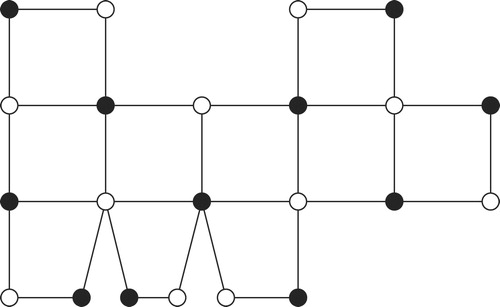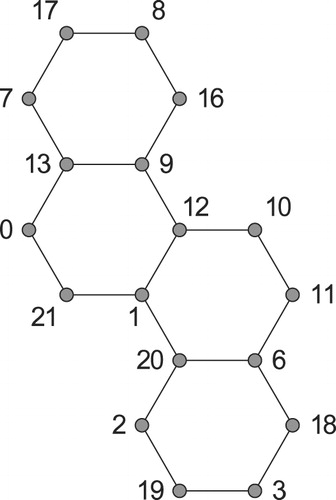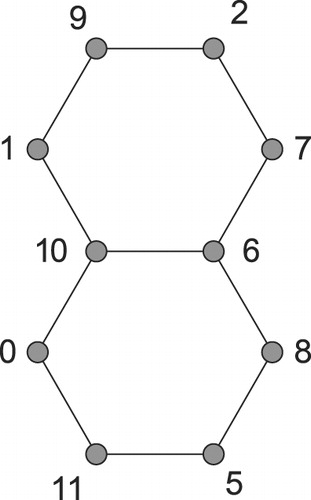Abstract
Barrientos and Minion (2015) introduced the notion of generalized snake polyomino graphs and proved that when the cells are either squares or hexagons, then they admit an alpha labeling. Froncek et al. (2014) generalized the notion by introducing straight simple polyominal caterpillars with square cells and proved that they also admit an alpha labeling.
We introduce a similar family of graphs called full hexagonal caterpillars and prove that they also admit an alpha labeling. This implies that every full hexagonal caterpillar with edges decomposes the complete graph
for any positive integer
.
1 Introduction
At the Forty-Fifth Southeastern International Conference on Combinatorics, Graph Theory, and Computing in Boca Raton in March 2014, Minion presented her joint results with Barrientos on alpha labelings of snake polyominoes and other related graphs (they later published it in [Citation1]). Froncek, Kingston, and Vezina [Citation2] generalized the notion by introducing straight simple polyominal caterpillars with square cells and proved that they also admit an alpha labeling. In this paper, we introduce a similar class of graphs with hexagonal cells, called full hexagonal caterpillars and prove that they also admit an alpha labeling.
Barrientos and Minion [Citation1] define a snake polyomino as a chain of edge-amalgamated cycles
of the same length with the property that
shares one edge with
,
shares one edge with
, and for
, each
shares one edge with
and another edge with
. Note that no edge appears in more than two of those cycles. They proved that such a snake polyomino has an alpha labeling whenever the cycles are of length four or six.
Froncek, Kingston, and Vezina [Citation2] generalized this notion for square polyominoes and defined a straight simple polyominal caterpillar as follows. The spine of the caterpillar is a straight snake polyomino in which the edges of shared with
and
are non-adjacent, which means that every vertex is of degree at most three. The spine can be also viewed as the Cartesian product
. We denote the vertices of the two paths as
and
, respectively. A straight simple polyominal caterpillar then can be constructed by amalgamating at most one four-cycle to each of the edges
and
for
. Notice that we can amalgamate the four-cycles to none, one, or both of the two edges
and
for any admissible value of
. The number of four-cycles in the spine is the length of the caterpillar. An example is shown in .
We generalize the notion for hexagonal polyominoes in a rather restricted form and define full hexagonal caterpillars of length as follows. The spine is a hexagonal chain (see [Citation1]) consisting of
six-cycles,
, where
consists of edges
numbered consecutively clockwise. Cycle
shares edge
with
,
shares edge
with
and
with
,
shares edge
with
and
with
, and so on. More precisely, we have
when
is even and
when
is odd.
The legs are six-cycles , where
consists of edges
numbered consecutively clockwise. For
, cycle
shares edge
with
, where
when
is odd, and
when
is even. An example of a full hexagonal caterpillar
of length
is shown in .
2 Supporting results and tools
Rosa [Citation3] introduced in 1967 certain types of vertex labelings as important tools for decompositions of complete graphs into graphs with
edges.
A labeling of a graph
with
edges is an injection from
, the vertex set of
, into a subset
of the set
of elements of the additive group
. Let
be the injection. The length of an edge
is defined as
. The subtraction is performed in
and hence
. If the set of all lengths of the
edges is equal to
and
, then
is a rosy labeling (called originally
-valuation by Rosa); if
instead, then
is a graceful labeling (called
-valuation by Rosa). A graph admitting a graceful labeling is called a graceful graph. A graceful labeling
is said to be an alpha labeling if there exists a number
(called the boundary value) with the property that for every edge
with
it holds that
. Obviously,
must be bipartite to allow an alpha labeling. A graph admitting an alpha labeling is called an
-graph. For an exhaustive survey of graph labelings, see [Citation4] by Gallian.
Let be a graph with at most
vertices. We say that the complete graph
has a
-decomposition if there are subgraphs
of
, all isomorphic to
, such that each edge of
belongs to exactly one
. Such a decomposition is called cyclic if there exists a graph isomorphism
such that
for
and
.
Each graceful labeling is of course also a rosy labeling. The following theorem was proved by Rosa in [Citation3].
Theorem 2.1
A cyclic -decomposition of
for a graph
with
edges exists if and only if
has a rosy labeling.
The main idea of the proof is the following. has exactly
edges of length
for every
and each copy of
contains exactly one edge of each length. The cyclic decomposition is constructed by taking a labeled copy of
, say
, and then adding an element
to the label of each vertex of
to obtain a copy
for
.
For graphs with an alpha labeling, even stronger result was proved by Rosa.
Theorem 2.2
If a graph with
edges has an alpha labeling, then there exists a
-decomposition of
for any positive integer
.
The proof is based on the observation that if we increase all labels in the partite set with labels exceeding by
, then all edge lengths will also stretch by
. Hence, we can take
copies of
and increase the labels in the upper partite set in the
th copy by
, where
. This way we obtain edge lengths
, each exactly once.
Barrientos and Minion [Citation1] made the following observation.
Theorem 2.3
If of order
with
edges and
of order
with
edges are two
-graphs with boundary values
and
, respectively, then there exists their edge-amalgamation
of order
with
edges that is also an
-graph with boundary value
.
For let
be the partite sets with the lower labels, that is, at most
, and
the sets with the upper labels. Call the respective labelings
and
. Further, let
be the longest edge of
of length
and
the shortest edge of
of length 1. Then indeed
, and
.
Barrientos and Minion observed that one can amalgamate with
and
with
and increase the labels in
and
by
and labels in
by
to obtain the desired graph
. The amalgamated edge arising from
and
is called the link. Notice that the shortest edge of
is in the subgraph arising from
while the longest one is in the subgraph arising from
. The edge-amalgamation of
and
as described above will be denoted as
.
It is easy to observe that this concept can be used for consecutive amalgamation of any number of -graphs into a larger
-graph. We will use that observation in the next section.
3 Construction
Using the above result, we now prove that every full hexagonal caterpillar is an -graph. The proof will be performed by strong induction. We first prove the result for full hexagonal caterpillars of even length. We start with the base case for
.
The assertion of the lemma below follows directly from the labelings in .
Lemma 3.1
The full hexagonal caterpillar of length 2 has an alpha labeling such that the edge
has length 21 and the edge
has length 1.
Now we are ready to prove our result for even.
Theorem 3.2
The full hexagonal caterpillar of an even length
has an alpha labeling such that the edge
has length
and the edge
has length 1.
Proof
The base case has been established in Lemma 3.1. Now suppose we have a full hexagonal caterpillar of an even length
. Obviously, it has
edges. We remove the cycles
except edge
, which is equal to
and belongs to
as well. We obtain a full hexagonal caterpillar
of even length
. By our induction hypothesis,
has an alpha labeling with
of length
and
of length 1.
Now we apply Theorem 2.3, setting and
. It should be clear that
is the amalgamation
of the two full hexagonal caterpillars
and
with the required alpha labeling. □
An analogous result for odd is slightly weaker, as we do not require the shortest edge to be in any specific position.
Lemma 3.3
The full hexagonal caterpillar of length 1 has an alpha labeling such that the edge
has length 11.
The labeling is shown in .
Theorem 3.4
The full hexagonal caterpillar of an odd length
has an alpha labeling such that the edge
has length
.
Proof
The base case follows from Lemma 3.3. We start with a full hexagonal caterpillar of an odd length
. Obviously, it has
edges. We remove the cycles
and
except edge
, which is equal to
and belongs to
as well. Now we have a full hexagonal caterpillar
of even length
. By Theorem 3.2,
has an alpha labeling with
of length
and
of length 1.
We again apply Theorem 2.3 with and
. It should be clear that the amalgamation
of the two full hexagonal caterpillars
and
is
with the required alpha labeling. □
Combining Theorems 3.2 and 3.4, we get our main result immediately.
Theorem 3.5
Every full hexagonal caterpillar admits an alpha labeling.
The result on decompositions of complete graphs into full hexagonal polyominal caterpillars follows directly from Theorems 3.5 and 2.2.
Corollary 3.6
Every full hexagonal polyominal caterpillar with edges decomposes the complete graph
for any positive integer
.
4 Conclusion
There are two obvious directions for further research. One is looking at hexagonal caterpillars that are not full. That in our notation means that only some of the leg hexagons would be present. Although it does not seem so hard at the first glance, one has to realize that because a hexagon itself does not admit an alpha labeling, and also an alpha labeling of
with the proper placement of the edge of length one is not known (and although we are not going to present a proof here, we are reasonably sure that it does not exist), we would have to consider eight starting cases for caterpillars of length three. Studying only hexagonal caterpillars of even length is not much easier either, since we were not able to find a proper alpha labeling for a spine segment of length two with no legs attached (again, we are reasonably sure that it does not exist).
Another possibility would be to look at the case where more than one leg hexagon would be attached to the same spine edge. This seems to be even more complex problem than the above one. Finally, while Barrientos and Minion proved that all hexagonal snakes (they called them chains) admit alpha labelings, one could ask under what conditions there would exist alpha labelings of hexagonal rings.
Notes
Peer review under responsibility of Kalasalingam University.
References
- C.BarrientosS.MinionAlpha labelings of snake polyominoes and hexagonal chainsBull. Inst. Combin. Appl.7420157383
- D.FroncekO.KingstonK.VezinaAlpha labelings of straight simple polyominal caterpillarsCongr. Numer.22220145764
- A.RosaOn certain valuations of the vertices of a graphTheory of Graphs (Intl. Symp. Rome 1966)1967Gordon and BreachDunod, Paris349355
- J.GallianA dynamic survey of graph labelingElectron. J. Combin.222014# DS6




